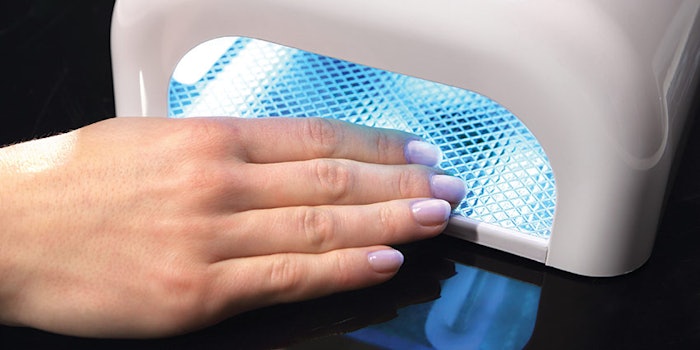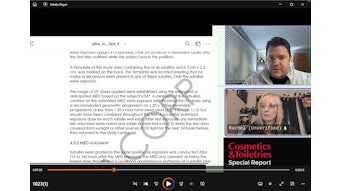
Cosmetic products placed on the market have high standards of safety and quality. As with several other areas around the world, Europe's cosmetics legislation is based on a system of in-market control; meaning there is no pre-authorization or registration. Full responsibility for ensuring product compliance and safety lies with the Responsible Person (RP). This is for any cosmetic product placed on the EU market. The competent authority in each EU Member State must take necessary control measures to ensure compliant products are on the market.
Cosmetic products must be safe under normal or reasonably foreseeable conditions of use. Unfortunately, despite stringent safety laws, a consumer may experience an undesirable effect (UE) from a cosmetic product although such UEs are rare. The German trade association IKW has an ongoing program that has been collating numbers of UEs from cosmetic products for many years. According to IKW, the figure has remained quite consistent; hovering at around one UE per million units sold.
Nevertheless, monitoring a cosmetic product's performance in the marketplace is a crucial part of the surveillance system to ensure consumer health protection is safeguarded, and to reduce the likelihood of UEs reoccurring. The EU cosmetics regulation requires the RP to keep the Cosmetic Product Safety Report (CPSR) up-to-date in light of any additional relevant information that may emerge after the product has been placed on the market.
Reviewing UEs reported by the consumer can help identify signals as to how a product is being tolerated by the population at large. If an unexpected rate in consumer contact for a specific product is experienced, this should prompt a company to investigate.
The term cosmetovigilance has been adopted to represent the monitoring of UEs to cosmetic products. Cosmetics Europe, the European personal care association, defines cosmetovigilance as: “The collection, evaluation and monitoring of spontaneous reports of undesirable events—including Serious Undesirable Effects (SUE)—observed during or after normal or reasonably foreseeable use of a cosmetic product. Spontaneous reporting gives meaningful indication on reporting rates, which are useful indicators to identify and describe possible signals.”1
However, the concept of addressing and documenting adverse effects is not new in the EU. In 1989, the European Commission undertook a feasibility study on an EU Cosmetosurveillance system. Discussions for an EU system and the trialling of harmonized reporting took place in the early 1990s. The requirement to keep information on UEs attributable to a cosmetic product in the Product Information File (PIF) was introduced in 1997, with the Sixth Amendment to the European Cosmetics Directive (76/768/EEC). In 2004, the Seventh Amendment to the Cosmetics Directive introduced Public Access to certain pieces of information, including the number of UEs attributable to a cosmetic product. At this time, some Member States introduced national schemes, and Cosmetics Europe proposed a harmonised industry approach.
When the EU Cosmetic Products Regulation 1223/2009 was implemented in 2013, it introduced definitions for both UEs and SUE, along with the requirement to report an SUE to a cosmetic product to the Competent Authority in the EU Member State where the SUE occurred.
The Cosmetics Regulation defines UE and SUE as follows:
“Undesirable effect” means an adverse reaction for human health attributable to the normal or reasonably foreseeable use of a cosmetic product.
“Serious undesirable effect” means an undesirable effect which results in temporary or permanent functional incapacity, disability, hospitalization, congenital anomalies or an immediate vital risk or death.
The term “temporary functional incapacity” in the definition of SUE is not defined further, and is indeed open to interpretation.
Companies need to have a procedure in place for handling complaints that facilitates the collection, response and recording of all adverse reactions related to their cosmetic products. This will assist in fulfilling the legal obligations for UEs and SUEs.
The key to a robust cosmetovigilance system is a common method of determining UEs and SUEs. For this reason, Cosmetics Europe not only updated its guidelines1 following the introduction of the Cosmetics Regulation, but also published this guidance.2
The European Commission’s Platform European Market Surveillance and Administrative Co-operation group (PEMSAC) has also issued guidance specific to SUE Reporting.3
Casualty Assessment
The causality assessment is fundamental to cosmetovigilance, as it helps determine if any adverse event reported is attributable to the cosmetic product being questioned.
There are five levels of causality: Very Likely, Likely, Not clearly attributable, Unlikely and Excluded.
The causality assessment is an analysis of three parameters:
- Can the symptoms be associated with the use of a cosmetic product?
- Is the time sequence appropriate (chronology)?
- Is there any medical confirmation or otherwise, or do the symptoms recur on re-exposure?
The Cosmetics Europe and PEMSAC guidelines provide the rationale and steps to performing a causality assessment, which may be carried out either using a decision table or a decision tree. After deciding that the symptoms are potentially valid, the next step is to determine whether the chronology of using the cosmetic product and the developed symptoms could be feasible. Finally, there are questions regarding any available medical report or if the consumer has used the product again that either confirms a link with the product, confirms there is no link or there is no conclusion. These steps lead to a final outcome and a level of causality.
UEs that are deemed to be Very Likely or Likely attributable to the cosmetic product must be kept in the Product Information File (PIF). All SUEs must be kept in the PIF and reported to the Competent Authority, unless the causality is excluded.
It must be remembered that an UE or even an SUE, however distressing for the consumer, may not necessarily mean the cosmetic product is unsafe or there is a serious risk to the population. However, if companies are seeing a high number of UEs for the same product they should investigate this, and there is a legal obligation to inform the safety assessor of UEs and SUEs.
The CPSR needs to take into account all available data on the UE/SUEs to the cosmetic product. Therefore, there needs to be an agreement between the Responsible Person and the Safety Assessor (or an internal process in place if the Safety Assessor is in-house) that any UEs and SUEs are communicated.
In order to help companies with the important causality assessment tool, CTPA is setting up a training program for both member companies and non-members.
While these requirements are a legal obligation in the EU, many other jurisdictions around the world require the monitoring of undesirable effects, whether as a legal obligation or as an industry voluntary commitment.
Any cosmetovigilance system is heavily dependent on the consumer contacting the company and also being willing to provide information for the causality assessment to be performed. It must though be remembered that cosmetovigilance provides information on the cosmetic product, and is of limited value in identifying critical ingredient(s). This can only really be determined if the consumer undergoes patch testing in order to identify the exact ingredient responsible for the UE/SUE. Cosmetovigilance data are complementary to clinical data.
Gel Nails: Case Study
CTPA has a Working Group (WG) of member companies and dermatologists from the British Society for Cutaneous Allergy (BSCA). It is the objective of the group to create a forum where current and arising issues, relating to both product categories and ingredients, can be discussed. It is a means for sharing cosmetovigilance data and clinical observations. The WG discusses topics ranging from ingredients to final products, along with cosmetovigilance and consumer information.
One such issue of concern to U.K. dermatologists is the rising rates of sensitisation to build-up artificial “gel” nails that require a light source (either UV or LED) as part of the application process.
David Orton, U.K. dermatologist and a member of the CTPA-BSCA WG, has presented findings from his patch test clinic at both the European Society of Contact Dermatitis Congress in September 2016 and the British Association of Dermatologists Annual Meeting in July 2017. The talks highlight the rise in patients presenting at clinics with contact dermatitis to light-cured methacrylate nails. While this was normally presented as an occupational issue, dermatologists are now seeing an increase in sensitisation among the general population, with a growing proportion of patients using home nail kits.
A key aspect to light-cured nails is the use of the correct light source with the specific nail product. The acrylate monomers are “cured” to the hard polymer by the light. If the incorrect light source is used or if the time allowed for curing is not sufficient, higher levels of the monomer remain on the nail. It is the monomer that has the potential to cause a reaction. Avoiding excessive skin exposure, i.e. the skin around the nail itself, is also important.
While any resulting contact dermatitis is in itself an unpleasant condition for the consumer to develop, there are other possible implications. Acrylates have a wide range of applications, including in certain medical and dental procedures. If an individual develops an allergy to methacrylate chemicals, through exposure to the chemicals in nail applications, this can have implications for any future dental and medical procedures. Therefore highlighting the need to follow the use instructions carefully and that nail systems should only be used with the corresponding LED or UV lamp is specified by the manufacturer, which is paramount.
References
- cosmeticseurope.eu/download/bDlwOG4vQlBYcWV6Z21RK045bVFVZz09 (Accessed Sept. 5, 2017)
- G Renner et al, Cosmetics Europe Guidelines on the Management of Undesirable Effects and Reporting of Serious Undesirable Effects from Cosmetics in the European Union, Cosmetics 4 (1) (2017)
- ec.europa.eu/docsroom/documents/13251/attachments/1/translations/en/renditions/pdf (Accessed Sept. 5, 2017)
- ec.europa.eu/docsroom/documents/13251/attachments/2/translations/en/renditions/pdf (Accessed Sept. 5, 2017)











